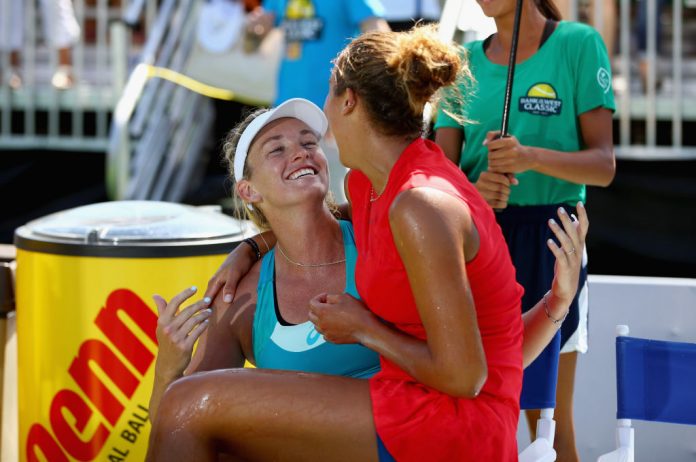THE END OF AN ERA?
They were everywhere.
LA, San Jose and San Diego.
Sports fans couldn’t miss them – Indian Wells, Carson and Stanford.
They gave us the best in the game, shining stars we knew by simply a single name, Chrissie, Martina, Jimbo and Serena, or by a couple of names, like that gal Billie Jean or brothers Bob and Mike.
Mom may have served up mac and cheese, but tennis in California gave us Mac and Keys – i.e. McEnroe and Madison Keys.
Some were Nasty (Ilie Nastase), others quite nice (Clijsters and Ashe).
Earthy athletes thrilled us – Agassi, Sampras, Murray and Maria. Others were out of this world, like The Rocket (Andy Roddick) and that planetary lady, Venus.
Once there was such bounty – California’s tennis tournaments seemed as common as the afternoon sun. And, like our own bright star, we took them for granted. And why not? Just eight years ago California had six ATP and WTA tournaments – Indian Wells, LA, San Jose, Stanford, Carlsbad and Carson.
Now we might be left with just one.
The WTA’s Northern California event – call it the Bank of the West Classic or just Stanford – is on life support. Stanford has made it clear that they do not want to host a tournament with a commercial sponsor. In other words, they don’t want a pro tennis tournament.
Never mind that the Bank of the West tournament is a mid-Peninsula, mid-summer rite that has brought countless delights. Never mind that for 22 years this international competition has enlivened the sleepy summer campus with a compelling world-class event – crowds cheer, families enjoy. Never mind that the low-key tourney was probably the least commercial tennis happening this side of Wimbledon.
And, yes, never mind that the good and great Stanford is in the heart of Silicon Valley. Just Google it or simply Facebook the facts – the last time we looked it’s the most commercial neighborhood west of Wall Street. And never mind that Stanford helped launch a commercial boom like no other, the cyber revolution, and that it’s a commercial juggernaut. After Harvard and Yale, no other private college has a heftier endowment.
More-than-revered Stanford, where tuition is over $46,000 a year, is said to be a $5.9 billion enterprise with a $22.4 billion endowment and an annual $774 million budget. And its health care centers and children’s hospital, which are not included in these stats, are themselves extraordinary enterprises.
But there can be no commercial backer of events on campus. IBM can’t bring an impressionist art show and the Bank of the West can no longer sponsor a modest tennis happening which over decades brought us bright young talents from distant Yugoslavia (Monica Seles) or from around the corner (Atherton’s CiCi Bellis) and showcased great story lines. Billie Jean came to town after coming out, and just last summer Sharapova made her first North American appearance here after serving her suspension.
So never mind that America needs as many great tennis tourneys as possible – Stanford is an academic institution in the business of teaching. Certainly the Bank of the West Classic doesn’t teach us a thing about women. Founded in 1971, it’s merely the oldest women-only tournament in the world. And it didn’t inform us at all about women and race when Serena and Venus brought their great and gritty street cred to the leafy Farm.
Never mind that they embody one of the most inspirational ghetto-to-greatness stories in America. And never mind that 1995 doubles finalist Katrina Adams is now the president of the USTA or that American ladies both little (Rosie Casals) and large (Lindsay Davenport) claimed the tourney’s trophies, or that Evonne Goolagong emerged out of the Australian outback to win. And never mind that Navratilova (the serve-and-volleyer who came out of the cold) escaped Czech communism and went on to cash big checks. And, for sure, there was nothing to be learned about big picture, why-can’t-we-just-get along harmony when the Israeli Jew Shahar Peer and the Indian Muslim Sania Mirza joined forces to win the 2007 doubles.
Never mind that the tournament was key to fundraising for great kid-friendly groups like East Palo Alto Tennis and Tutoring, and Youth Tennis Advantage, that it annually hosts the NorCal Hall of Fame, that each summer it gives the school publicity around the world and helps Stanford tennis greatly.
Simply put, the tournament is a jewel. Yet earlier this year Stanford tripled the six-figure rent it was charging. The tourney’s owner, the Cleveland-based sports agency IMG, bristled, but eventually agreed. The Bank of the West’s parent company, BNP Paribas, told it to redirect the sponsorship funds it had for Stanford into BNP’s Indian Wells extravaganza. But, after much gnashing and grinding, the Bank of the West changed its mind and agreed to again sponsor the tourney, a Middle East investment firm that was coming to San Francisco and wanted to make a splash.
A ready-to-be-signed contract for 2018 was sent to Stanford. But, despite the wishes of Stanford tennis and Stanford athletics, the university ultimately refused to budge from its puzzling, counterproductive edict that no commercial entity could sponsor a campus event.
IMG still owns the valuable sanction for the event, but, as of now, has neither a site nor a sponsor. Playing it indoors, like the long-gone SAP Open, reportedly is not an option. According to sources, IMG has had talks with San Jose State, Silicon Valley and East Bay clubs as well as eastern sites including North Carolina and Atlanta.
If it ends up that the BNP Paribas Open, which once was so threatened and now thrives, survives as the last of California’s six tournaments, there will be many take-aways: tradition has little value. The gears of bureaucracies can grind strong. Fabulous institutions can make wretched decisions. And the tennis community – regionally and nationally – can be ineffective and impotent. (Memo to the USTA – please step in and help clean up this mess!)
Then again, just maybe, IMG (which is struggling to get a new site for its vitally important Miami Open) might shock us all and pull a rabbit out a Bay Area hat – and one of the great treasures of woman’s tennis will stay here in California, where it was born, and where it belongs.




















Too bad: I was looking forward to seeing Serena there this year as she makes her comeback. I’m sure there are plenty of commercial events at Stanford, hidden in different ways. Aren’t scholarships commercial
if they bear the name of their sponsor? Don’t private companies help fund concerts and art shows, or
is all that money from Stanford endowments in fact, isn’t an endowed chair commercial?).
Seems to me there an underlying reason for that we don’t know about behind the transfer to Cal State San Jose.
Please explain and please keep the tournament at Stanford.
Ellen Murray
Mountain View, California